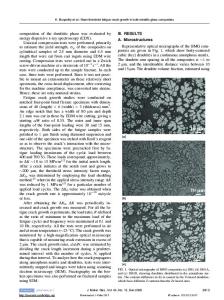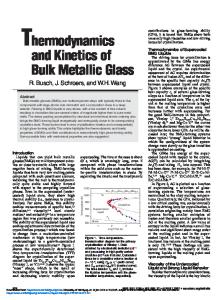Stability of ZrTiCuNiBe bulk metallic glass upon isothermal annealing near the glass transition temperature
- PDF / 154,247 Bytes
- 5 Pages / 612 x 792 pts (letter) Page_size
- 54 Downloads / 299 Views
Ju Wang and W.T. Yang Institute of Physics & Center for Condensed Matter Physics, Chinese Academy of Sciences, P.O. Box 603, Beijing 100080, People’s Republic of China
B.C. Wei National Microgravity Laboratory of Chinese Academy of Sciences, Beijing 10080, People’s Republic of China
P. Wen, D.Q. Zhao, and M.X. Pan Institute of Physics & Center for Condensed Matter Physics, Chinese Academy of Sciences, P.O. Box 603, Beijing 100080, People’s Republic of China (Received 28 February 2001; accepted 18 March 2002)
The stability of Zr41Ti14Cu12.5Ni10Be22.5 bulk metallic glass (BMG) upon isothermal annealing near the glass transition temperature has been investigated by using x-ray diffraction, differential scanning calorimetry, and the pulse echo overlap method. The density, elastic constants, and thermodynamic parameters as well as their annealing time dependence have been determined. The microstructural and properties changes of the annealed BMG were checked by acoustic measurement. Obvious structural and property changes were observed with prolonged annealing of the BMG near the glass transition temperature. I. INTRODUCTION 1
Since the discovery of metallic glass in 1960, much research has been devoted to study the formation mechanism and crystallization of metallic glasses. However, the lack of thermal stability in the supercooled liquid of metallic system with respect to crystallization makes the studies of glass transition and nucleation in the metallic alloys very difficult. Recently, a number of multicomponent alloys with high thermal stability of the supercooled liquid against crystallization have been found. The stability has enabled the production of bulk metallic glasses (BMGs) by using various casting processes.2 On the other hand, the novel bulk glassy forming liquids can now be studied in much broader time and temperature ranges. The study of stability and nature of the BMG is very important for understanding the excellent glassforming ability (GFA), the crystallization, and the applications of the BMGs.2,3 However, the mechanism for the strong stability of the BMGs has not been solved yet. The acoustic method is a powerful tool for studying the structural change and fundamental elastic and thermal behaviors as well as relationship between microstructure and properties. Zr-based BMGs can be produced in a large a)
Address all correspondence to this author. e-mail: [email protected] J. Mater. Res., Vol. 17, No. 6, Jun 2002
http://journals.cambridge.org
Downloaded: 15 Mar 2015
3-dimension size, and they show a wide supercooled liquid region.2,3 The bulky size of the BMGs is suitable for measurement of elastic wave propagation. The wide supercooled liquid region makes them ideal systems to study the stability and accurately measure structural and physical properties during the prolonged isothermal annealing in the supercooled liquid region.4,5 Since the acoustic property is particularly sensitive to the microstructure,6 the acoustic velocities can reflect critical information on microstructural evoluti
Data Loading...











